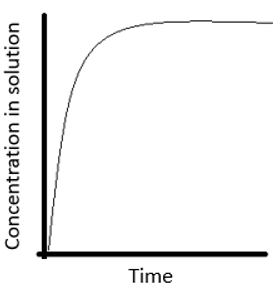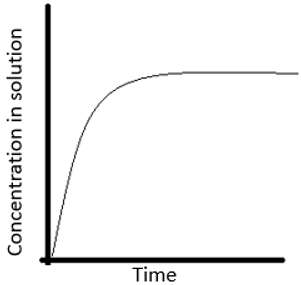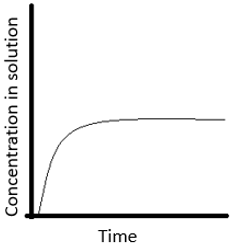This set of Drug Biotechnology Questions and Answers for Aptitude test focuses on “Bioavailability – Methods for Enhancement”.
1. Poor bioavailability means poor aqueous solubility.
a) True
b) False
View Answer
Explanation: A drug with poor bioavailability means the drug can also have poor aqueous solubility, slow dissolution rate in plasma or other biological fluids. The drug can also have poor stability of the dissolved drug at the patient’s body pH, inadequate partition coefficient, and extensive presystemic metabolism.
2. A drug with poor stability means higher bioavailability.
a) True
b) False
View Answer
Explanation: Poor stability of the drug at physiological pH causes the difference in its disintegration, dissolution rate thus decreasing the bioavailability. The drug can also have poor stability of the dissolved drug at the patient’s body pH, inadequate partition coefficient, and extensive presystemic metabolism.
3. Which of the following is not an approach for overcoming bioavailability problems?
a) Pharmaceutic approach
b) Pharmacokinetic approach
c) Biologic approach
d) Partition coefficient approach
View Answer
Explanation: There are three approaches in overcoming the bioavailability problems these are the pharmaceutic approach, pharmacokinetic approach, and biologic approach. The pharmaceutic approach involves modification of formulation, manufacturing processes. The pharmacokinetic approach is in which the pharmacokinetics of the drug is altered by modifying its chemical structure. The biologic approach is where the route of administration can be changed.
4. What will be the particle size after micronization of drugs?
a) 1-10 micron
b) 10-20 micron
c) 20-30 micron
d) 1-5 micron
View Answer
Explanation: Micronization is a process where the size of the solid drug particles is reduced to 1-10 microns by spray drying or by using air attrition methods. Drugs such as griseofulvin and several steroidal and sulfa drugs are there whose bioavailability is increased by micronization.
5. What is the principle behind the use of surfactants?
a) Reducing the size of solid drug particles
b) Enhancing the dissolution rate by promoting wetting
c) Improving solubility
d) Alter the pH of the microenvironment
View Answer
Explanation: Surfactants enhance the dissolution rate by promoting wetting and penetration of dissolution fluid into the solid drug particles. These surfactants are used in a concentration below the critical micellar concentration since above CMC the trapped drug in the micelle structure fails to partition in the dissolution fluid.
6. Salts improve solubility and dissolution characteristics.
a) True
b) False
View Answer
Explanation: Salts improve solubility and dissolution property of the drug in comparison to the original characteristic. Alkali metal salts of acidic drugs and strong acidic salt of the basic drug are more water soluble than the parent drug. For example penicillin and atropine respectively.
7. How pH alteration of the drug microenvironment is done?
a) Altering the pH while the administration
b) In situ salt formation
c) Altering the pH of the tissue
d) Formulating the drug in such a way that it gets activated only when it reaches the tissue pH
View Answer
Explanation: Alteration of pH of the drug microenvironment is done in two ways. One of that is in-situ salt formation, and other is the addition of buffers to the formulation e.g. buffered aspirin tablets. We cannot depend on tissue pH since it changes person to person.
8. Which one of the following is used for selective adsorption on insoluble carriers of the drugs?
a) Freeze drying
b) Organic solvent
c) Inorganic clays like bentonite
d) Creating metastable polymorphs
View Answer
Explanation: In the process of selective adsorption on insoluble carriers a highly active adsorbent as the inorganic clays like bentonite can enhance the dissolution rate of poorly aqueous soluble drugs such as indomethacin, it maintains the concentration gradient at its maximum.
9. Which of the following is used in the solvent deposition method of enhancing bioavailability?
a) Freeze drying
b) Organic solvent
c) Inorganic clays like bentonite
d) Creating metastable polymorphs
View Answer
Explanation: Insolvent deposition method, poorly aqueous soluble drugs are dissolved in an organic solvent such as alcohol and deposited on an inert, hydrophilic, solid matrix such as that of starch or microcrystalline cellulose by evaporation of the solvent.
10. Which of the following is used in solid solutions method of enhancing bioavailability?
a) Highly water-soluble compound
b) Organic solvent
c) Inorganic clays like bentonite
d) Creating metastable polymorphs
View Answer
Explanation: There are three different ways of solid solutions these are the use of the solid solution, use of eutectic mixtures, and the use of solid dispersions. In all these cases the solute or the drug is most of the times not soluble in water acts as a guest and the solvent used is highly water-soluble compound or polymer acting as a host or carrier.
11. In the below picture which form of solid solution of griseofulvin with succinic acid is shown?

a) Solid solution
b) Eutectic mixture
c) Micronized drug
d) Coarse drug
View Answer
Explanation: Solid solutions are prepared by fusion method where a mixture of solute and solvent are melted together followed by rapid solidification. Such systems are prepared by fusion and are called as melts e.g. griseofulvin-succinic acid. Solid solution is binary system with solid solute dispersed in solid solvent. Eutectic mixtures are physically blended mixture of two crystalline compound.
12. In the below picture which form of solid solution of griseofulvin with succinic acid is shown?

a) Solid solution
b) Eutectic mixture
c) Micronized drug
d) Coarse drug
View Answer
Explanation: Solid solutions are prepared by fusion method where a mixture of solute and solvent are melted together followed by rapid solidification. Such systems are prepared by fusion and are called as melts e.g. griseofulvin-succinic acid. Solid solution is binary system with solid solute dispersed in solid solvent. Eutectic mixtures are physically blended mixture of two crystalline compound.
13. In the below picture which form of solid solution of griseofulvin with succinic acid is shown?

a) Solid solution
b) Eutectic mixture
c) Micronized drug
d) Coarse drug
View Answer
Explanation: Solid solutions are prepared by fusion method where a mixture of solute and solvent are melted together followed by rapid solidification. Such systems are prepared by fusion and are called as melts e.g. griseofulvin-succinic acid. Solid solution is binary system with solid solute dispersed in solid solvent. Eutectic mixtures are physically blended mixture of two crystalline compound.
14. In the below picture which form of solid solution of griseofulvin with succinic acid is shown?

a) Solid solution
b) Eutectic mixture
c) Micronized drug
d) Coarse drug
View Answer
Explanation: Solid solutions are prepared by fusion method where a mixture of solute and solvent are melted together followed by rapid solidification. Such systems are prepared by fusion and are called as melts e.g. griseofulvin-succinic acid. A solid solution is a binary system with solid solute dispersed in a solid solvent. Eutectic mixtures are physically blended mixture of two crystalline compounds.
15. Which of the following is used in molecular encapsulation of drugs for enhancing bioavailability?
a) Highly water-soluble compound
b) Cyclodextrin
c) Inorganic clays like bentonite
d) Creating metastable polymorphs
View Answer
Explanation: Beta and gamma Cyclodextrin and other derivatives have the ability to form molecular inclusion complexes with hydrophobic drugs having poor aqueous solubility. These Cyclodextrin molecules have a hydrophobic cavity which can accommodate the lipophilic drugs as a guest. The outside of which is hydrophilic.
Sanfoundry Global Education & Learning Series – Drug and Pharmaceutical Biotechnology.
To practice all areas of Drug Biotechnology for Aptitude test, here is complete set of 1000+ Multiple Choice Questions and Answers.
If you find a mistake in question / option / answer, kindly take a screenshot and email to [email protected]
- Check Biotechnology Books
- Apply for Biotechnology Internship
- Practice Biotechnology MCQs
- Check Drug and Pharmaceutical Biotechnology Books
